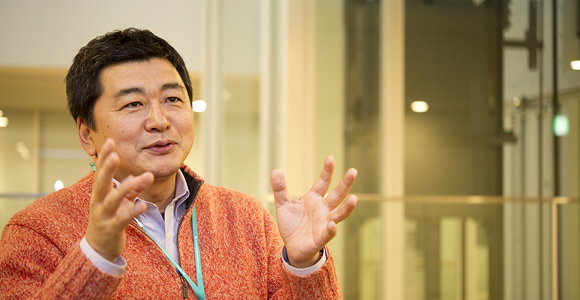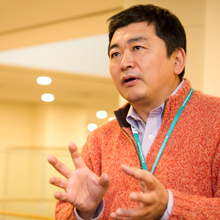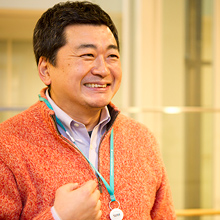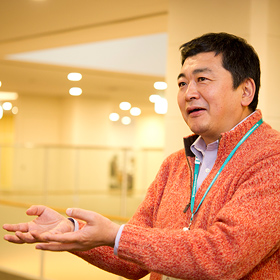Tomoaki Sakurai

SDM is a place where I can use an integrated,
logical process to restructure disorderly,
intuitive experiences
Tomoaki Sakurai
(entered spring, 2010), graduated from the normal course at Aomori Prefectural Misawa High School
Member of the Air Self‐Defense Force and worked for a technology trading house, a satellite communications company, and internet-related companies before joining Nano-Optonics Energy Inc.
I've been involved in numerous projects in numerous settings. Each one has given me new experiences and knowledge, but the knowledge that I have accumulated has been entirely experiential, and I began to realize its limits. It was at that time that I had a chance to speak with Prof. Ohkami, the former dean, and he told me, "The limits on existing systems are the limits on large-scale projects. There needs to be a methodology for building large, complex systems." He went on to discuss the importance of being able to see the trees but also the forest. As I listened to him, I decided that I needed to be able to organize and systematize my experiences and bring new perspectives to them, and it was with that in mind that I decided to enter SDM.
 There are very few schools anywhere in the world that teach system design and management, and I remember being a bit anxious about what I would actually be learning. I could not initially imagine how the individual classes fit together, but in talking with other members after classes got out, we began to teach each other. The individual points gradually started to form planes, and the planes became solid, three-dimensional objects. This process of coming to understand a carefully designed system was very satisfying to my intellectual curiosity.
There are very few schools anywhere in the world that teach system design and management, and I remember being a bit anxious about what I would actually be learning. I could not initially imagine how the individual classes fit together, but in talking with other members after classes got out, we began to teach each other. The individual points gradually started to form planes, and the planes became solid, three-dimensional objects. This process of coming to understand a carefully designed system was very satisfying to my intellectual curiosity.
You can categorize what is taught at SDM basically as "system thinking," "design thinking" or "management thinking." It is not only an opportunity to restructure and systematize the experiences and knowledge you have gained in the course of ordinary work, it is a chance to understand broad social systems and develop logical, scientific habits of thought. This gives you new perspectives and, I believe, helps you to create more value.
My only regret is that there are only 24 hours in a day.
Research theme: Design of space situation awareness systems based on dual use concepts
My company conducts joint research with a number of universities.
One of our projects is to develop a 3.8m optical infrared telescope, which we are doing with Nagoya University and Kyoto University. We hope that the optical infrared telescope can be used in a space situation awareness system to observe "space debris." My specific research theme is "design of space situation awareness systems based on dual use concepts." I am studying approaches for the design, fabrication, and operation of systems that achieve total optimization when they are used by multiple companies and organizations.
From this focus, I am also researching security and energy systems. SDM is broad, and there are no limits on what can be studied. What interests me most is the process of applying the approaches and techniques we learned at SDM to solve a wide variety of problems.
The social value of SDM
SDM is not just an educational institution; it is also a place for joint research with different companies and organizations, and it tackles a wide variety of fields. This joint research will, I think, enable more people to understand the SDM philosophy, and give the school greater social impact.
There are large numbers of working and returning students, including many who have been sent to the school by their companies. The idea of moving from partial optimization to total optimization seems simple, but it is extremely difficult in practice, and it may take time before it is accepted by society at large.
Collaborating with members who have sharply different backgrounds
 The ALPS project takes about six months, and is interesting for a number of reasons. The 2010 ALPS used research themes proposed by companies to investigate new services and products. My team studied "potential for renewable energy in disaster prevention." We analyzed the damage and impact from natural phenomena and natural disasters, studied megasolar generators, hydroelectric generators, wind power generation, and even made a trip to Ashikaga Institute of Technology, where they are researching the use of solar heat. For our final proposal, we fabricated a COTS prototype. Working with people of such diverse backgrounds presented some difficulties, but it was a valuable experience.
The ALPS project takes about six months, and is interesting for a number of reasons. The 2010 ALPS used research themes proposed by companies to investigate new services and products. My team studied "potential for renewable energy in disaster prevention." We analyzed the damage and impact from natural phenomena and natural disasters, studied megasolar generators, hydroelectric generators, wind power generation, and even made a trip to Ashikaga Institute of Technology, where they are researching the use of solar heat. For our final proposal, we fabricated a COTS prototype. Working with people of such diverse backgrounds presented some difficulties, but it was a valuable experience.
ALPS may be finished, but I still have good relationships with the mentor company, and this has led to new things since the ALPS presentation.
Another experience that stands out is a research project called "Movie in the Dark" in which normally-sighted people are asked to enjoy a movie together with someone who is visually impaired. I have done voice work at Nippon Cultural Broadcasting, so I was selected to narrate the audio guide, which led to my participation in the project. Ordinarily, audio guidance is heard on headphones, but in this project it was to be inserted in between the movie's dialogue. There was much to communicate and very little time to do it. How to achieve that and not destroy the overall balance of the movie was a very challenging problem. We worked together with film audio professionals on revising the scripts over and over again, carefully choosing our words and controlling our emotions. It was stressful, but rewarding. The best part was hearing the expressions of thanks and joy from the people who viewed the screening at the Fujiwara Hiroshi Memorial Hall in the Collaboration Complex.
SDM is a place where you gain new knowledge and insights by helping out with someone else's research.
Broadly based, broadly applicable
 There have been many interesting classes, but the one that stands out most was "Science and Philosophy of Systems." Systems are built by human beings, and inasmuch as humans are building them, they are incorporating their ideas and intentions into them. The class was every bit as interesting as I had hoped; the process of group work discussions, interim presentations, and final presentations gave me the experience of thinking about things from multiple perspectives and caused me to rethink my own life and approaches. As I pondered these mysteries, NHK began broadcasting Harvard professor Michael Sandel's "Justice" series, which complemented the SDM class well.
There have been many interesting classes, but the one that stands out most was "Science and Philosophy of Systems." Systems are built by human beings, and inasmuch as humans are building them, they are incorporating their ideas and intentions into them. The class was every bit as interesting as I had hoped; the process of group work discussions, interim presentations, and final presentations gave me the experience of thinking about things from multiple perspectives and caused me to rethink my own life and approaches. As I pondered these mysteries, NHK began broadcasting Harvard professor Michael Sandel's "Justice" series, which complemented the SDM class well.
Another thing that makes SDM so enjoyable is that you are not walled off in your own laboratory. Many different professors and instructors are there to give you advice on your research from many different perspectives.
There is incredible breadth and depth in the subjects being investigated, and it is that broad basis and broad applicability that makes SDM so compelling as a graduate school.

